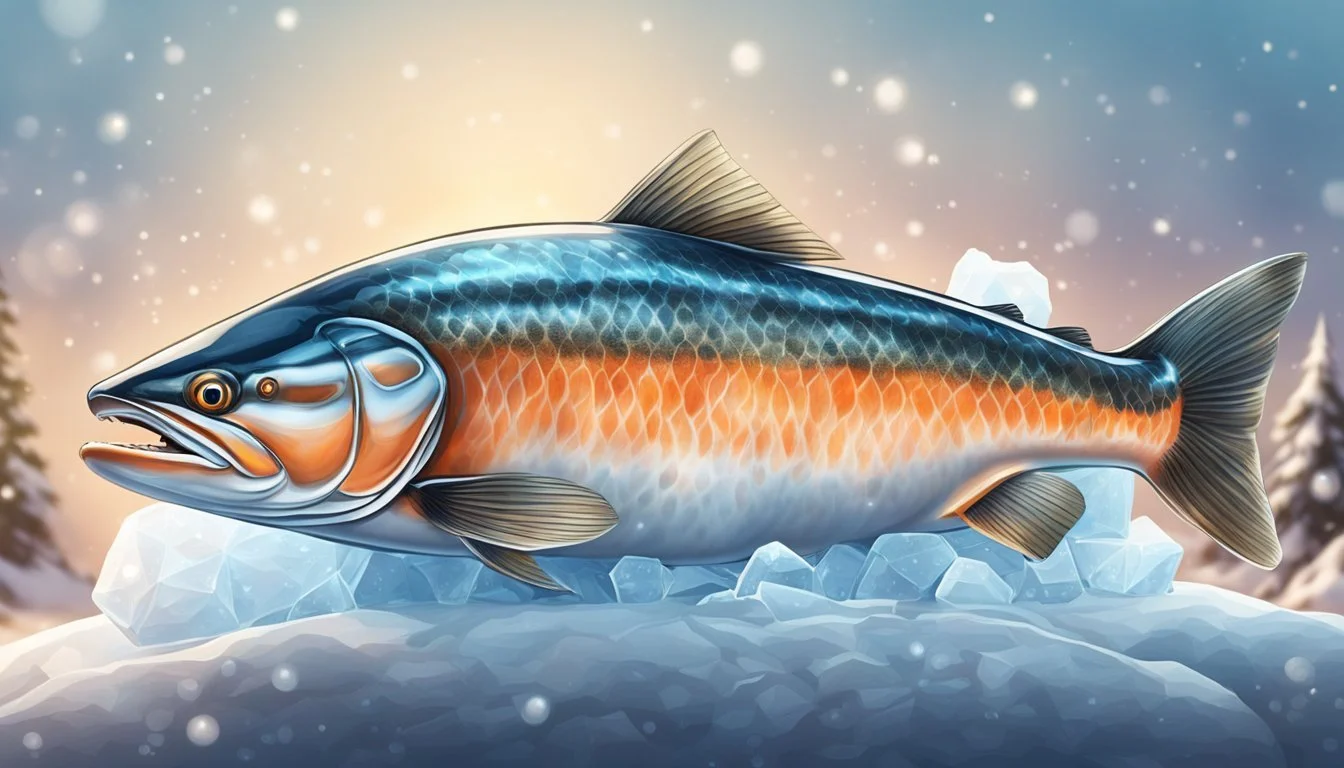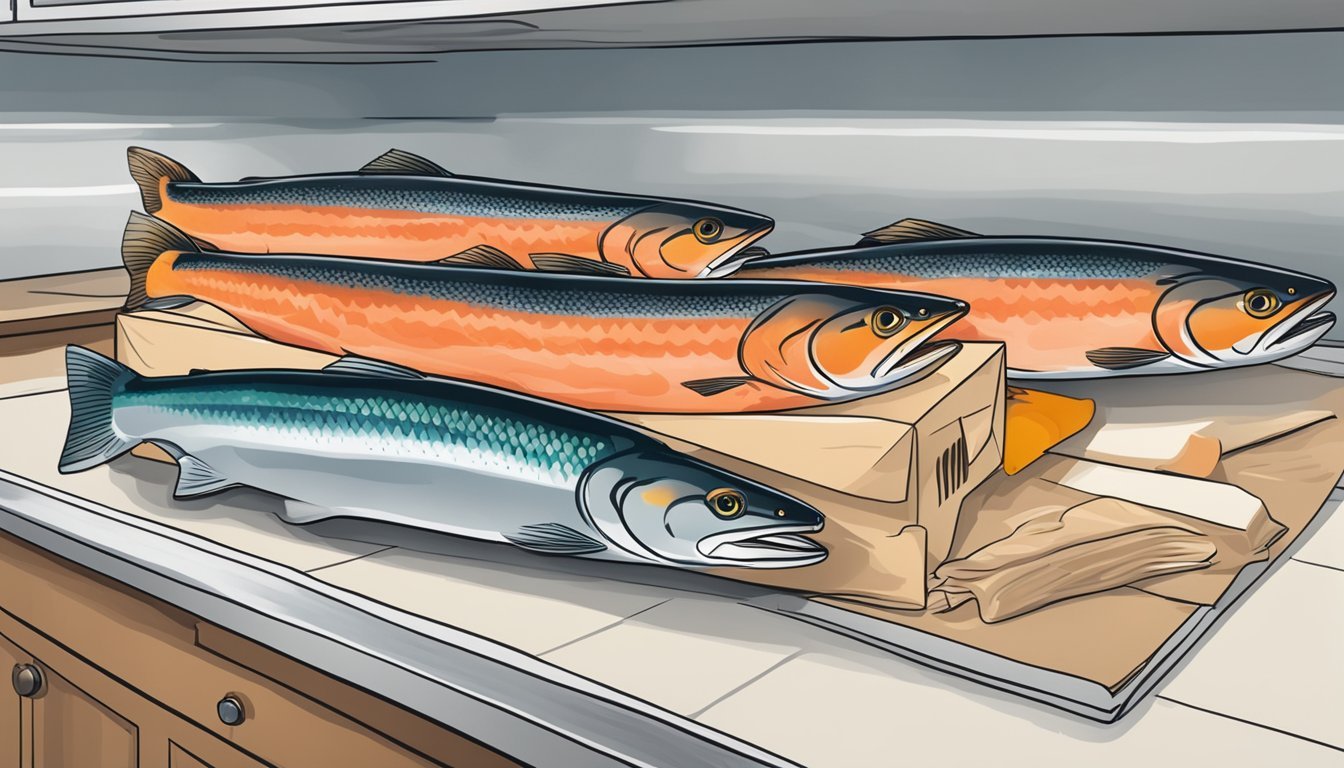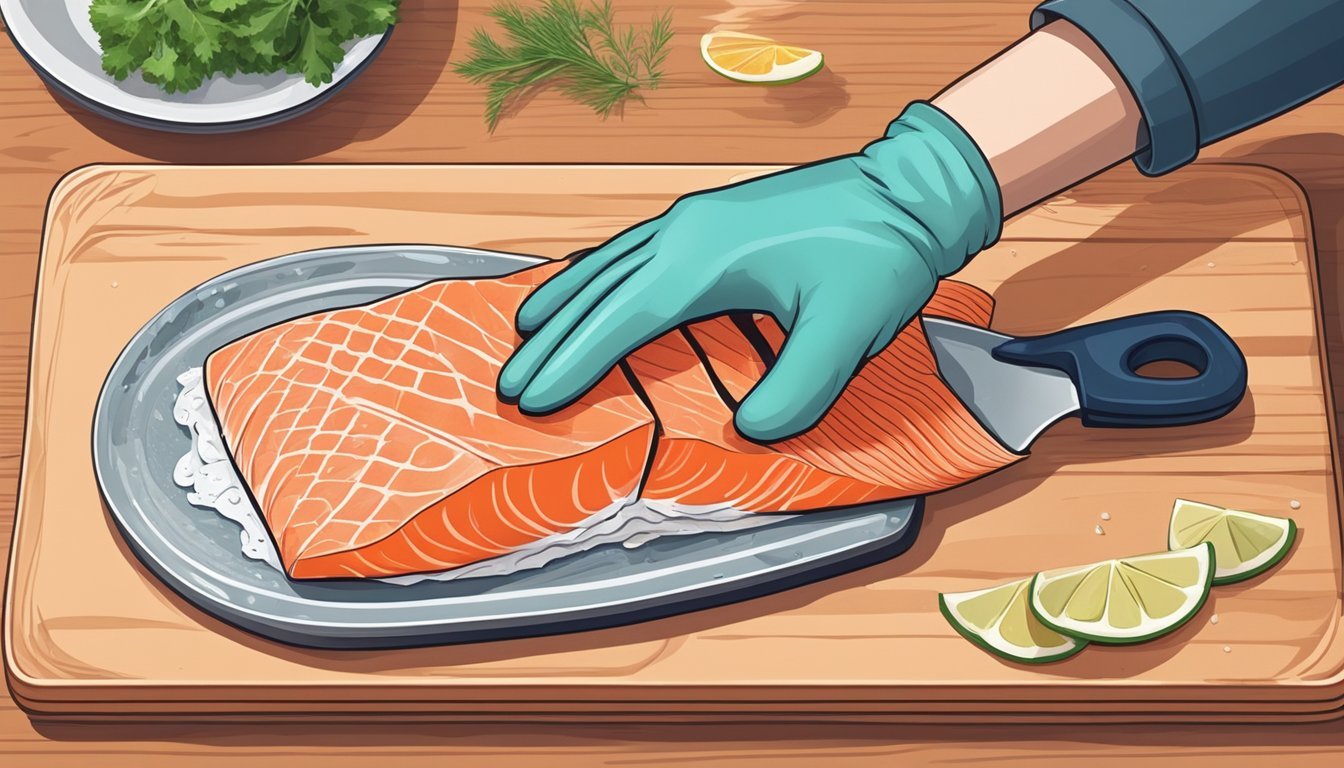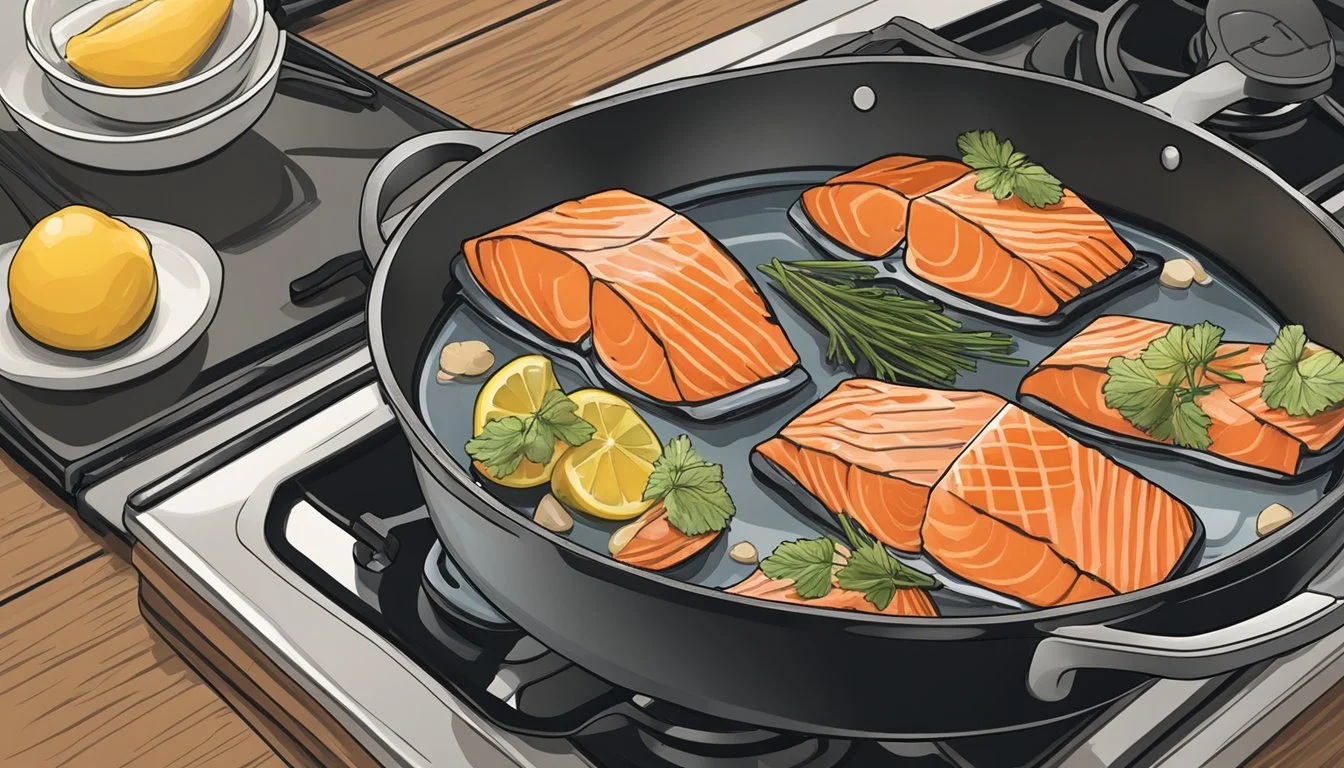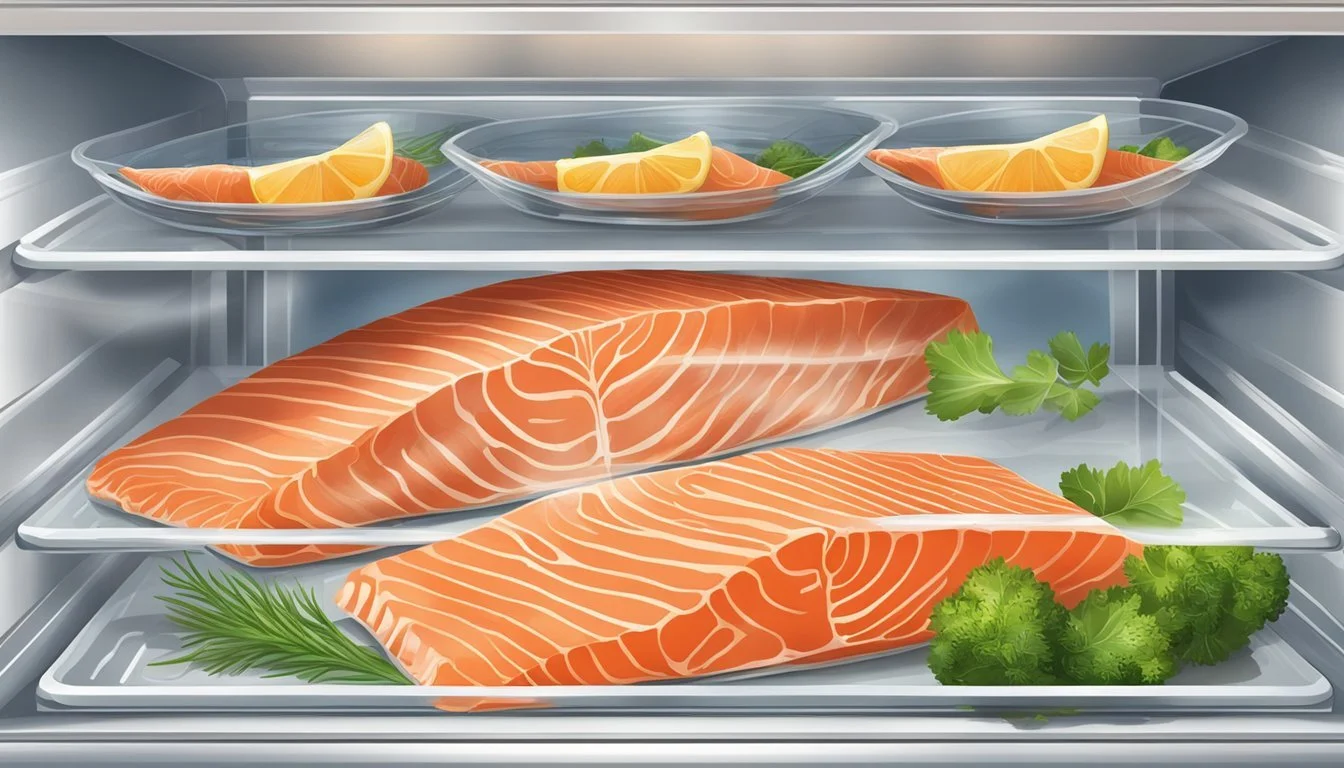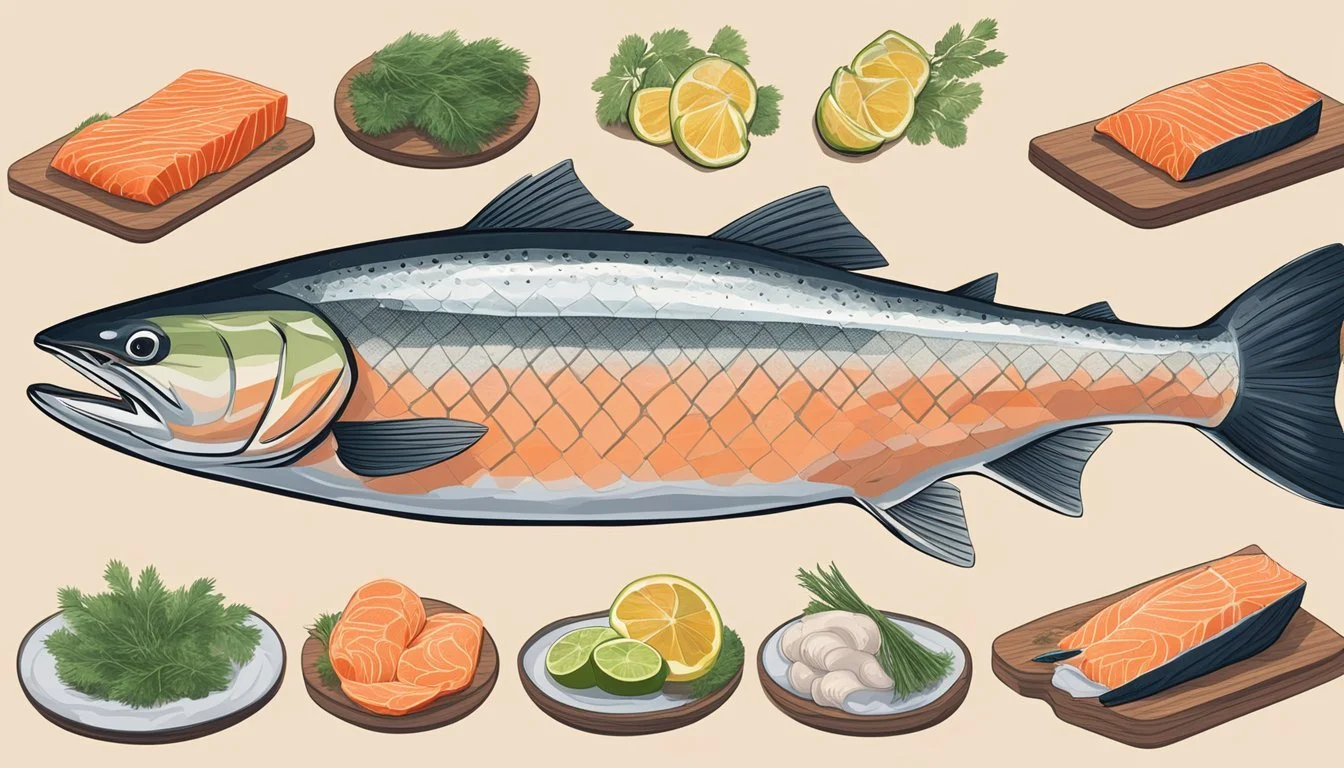How Long Does Salmon Last?
Shelf Life and Storage Tips
The preservation of salmon's (What wine goes well with salmon?) freshness is contingent upon proper storage, which directly affects its longevity and quality. When sealed in its original packaging, cold smoked salmon can remain fresh in the refrigerator for up to a month, while the shelf life of vacuum-packed cold smoked salmon may extend slightly longer due to the absence of oxygen. For raw or cooked salmon that hasn’t been smoked, the window of freshness is significantly shorter; raw salmon should be consumed within one to two days of refrigeration to ensure quality and safety.
Freezing offers a viable solution for extending the shelf life of salmon. If properly stored in a freezer-safe container or vacuum-sealed bag, salmon can maintain its freshness for up to three months, although it may remain safe to eat beyond that time. However, the optimal quality is sustained up to the nine-month mark in a freezer set at 0 degrees Fahrenheit. Beyond this period, while still safe for consumption, the salmon may exhibit a decline in texture and flavor.
Observing smart storage practices is key to maximizing salmon's usable life. This includes maintaining a consistent refrigerator temperature of 40 degrees Fahrenheit or below and a freezer temperature of 0 degrees Fahrenheit. For cooked salmon, the guidelines for refrigeration are more generous — it can last safely for three to four days. Regardless of the storage method, it is vital to heed the indicators of spoilage such as a sour smell, a slimy texture, or a dull color, and discard any salmon that exhibits these signs to avoid potential foodborne illnesses.
Fundamentals of Salmon Storage
Proper salmon storage is crucial for maintaining its quality and safety. It involves understanding refrigeration guidelines, freezing techniques, and recognizing freshness. To ensure salmon retains its protein content, flavor, and texture, it's important to follow these specific storage methods.
Refrigeration Guidelines
Fresh salmon should be stored in the refrigerator immediately after purchase. It should be:
Wrapped tightly in plastic wrap or aluminum foil, or placed in an airtight container to retain moisture and prevent the absorption of odors.
Kept at a consistent temperature of 32°F to 34°F, which is often the coldest part of the refrigerator.
Cooked salmon also needs care:
Store in an airtight container to keep out moisture and other contaminants.
Consume within 3-4 days to ensure safety and quality.
Freezing Techniques
To prolong the shelf life of salmon, freezing is an effective method.
When freezing raw salmon:
Rinse the salmon, dry it thoroughly, and wrap in vacuum seal bags or freezer bags to protect against freezer burn.
Maintain a freezer temperature of 0°F or below. Frozen salmon can last 9-12 months when stored correctly.
Cooked salmon can be frozen by:
Cooling it completely and transferring it to an airtight container or tightly wrapped packaging before placing it in the freezer.
Recognizing Freshness
The freshness of salmon, which affects safety and taste, can be determined by several indicators:
Smell: Fresh salmon should have a mild, ocean-like scent. A strong fishy odor indicates spoilage.
Texture: It should have a firm texture. If the flesh is mushy or falls apart easily, it may not be fresh.
Gills and Eyes: For whole salmon, bright red gills and clear, glossy eyes are signs of freshness.
Coloration: Look for consistent, vibrant color. Any dullness or fading may suggest the fish is past its prime.
When in doubt, always check the label for the "sell by" date and follow the USDA guidelines for food safety.
Shelf Life and Spoilage Indicators
When considering the consumption of salmon, understanding its shelf life and identifying signs of spoilage are crucial for health and safety.
Determining Shelf Life
To guarantee the best quality and safety, smoked salmon sealed in its original packaging generally lasts in the fridge for two weeks to one month. For frozen salmon fillets, one can expect a shelf life of 9-12 months in the freezer when stored at 0 degrees Fahrenheit in a vacuum-sealed bag. Cooked salmon, once prepared, should be consumed within 3-4 days when refrigerated at or below 40°F.
Salmon Type Fridge Freezer Raw salmon fillet 1-2 days 6-9 months Cooked salmon 3-4 days N/A Smoked salmon 2 weeks - 1 month N/A
Signs of Spoiled Salmon
Salmon has gone bad if one observes a sour or ammonia-like odor, a telltale sign of bacterial growth and spoilage. The texture of the fish can also indicate spoilage; it becomes slimy to the touch when spoilage bacteria have multiplied. In terms of appearance, any discoloration or visible mold implies that the salmon is not fit for consumption. It's also important to note that bad salmon may have a dull or grayish coloration rather than the vibrant pink to red hue that signifies freshness.
Safe Salmon Handling Practices
In managing salmon, whether cold smoked or prepped for dishes, safe handling is critical to prevent foodborne illness. This includes proper thawing techniques and meticulous avoidance of cross-contamination, ensuring both food safety and quality.
Thawing Frozen Salmon
To thaw frozen salmon, the FDA recommends using one of three safe methods: refrigeration, cold water thawing, or using a microwave.
Refrigeration: Thaw salmon in the refrigerator, which may take up to 24 hours for larger fillets or slabs. Keep the salmon in its packaging during this process.
Cold Water Thawing: For quicker thawing, keep salmon in a sealed bag and immerse it in cold water. Change the water every 30 minutes to maintain safety and ensure consistent thawing.
Microwave: If time is short, use the microwave's defrost setting. However, cook the salmon immediately after to prevent any potential growth of bacteria.
Preventing Cross-Contamination
Cross-contamination can lead to foodborne illness. To prevent cross-contamination:
Separate Utensils: Use separate cutting boards, knives, and plates for raw salmon and other ingredients.
Clean Surfaces: Wash all kitchen surfaces and utensils with hot, soapy water after they come into contact with raw salmon.
Refrigeration: Store raw salmon below ready-to-eat dishes in the refrigerator. Keep it sealed and away from other foods to prevent any drip that might contaminate.
Food Preparation: Cook salmon to an internal temperature of 145°F as recommended by the USDA, to destroy any bacteria or parasites present.
One should not let salmon sit out at room temperature for more than 2 hours, as bacteria growth can occur rapidly at these temperatures, increasing the risk for food poisoning. Always maintain a clean kitchen environment when handling salmon to assure the safety and quality of your dishes.
Cooking and Reheating
Proper cooking and reheating methods are essential for maintaining the texture and flavor of salmon, whether incorporating the fish into salads, pairing it with rice, or enjoying it as the centerpiece of a meal.
Cooking Fresh Salmon
One should cook fresh salmon to an internal temperature of 145°F, ensuring the fish is thoroughly cooked while preserving its moisture and tender texture. The method used to cook the salmon can vary the outcome significantly:
Baking: Wrap the salmon in foil, season as per the recipe, and bake at 375°F for 12-20 minutes.
Grilling: Lightly oil the grill and cook the salmon skin-side down, flipping carefully once.
Pan-Frying: Heat oil over medium-high heat, placing the salmon skin-side down first, and cook for 3-4 minutes per side.
Reheating Guidelines
Reheating cooked salmon without overcooking or drying it out requires careful attention to time and temperature:
Oven:
Preheat to 275°F
Place salmon on a tray lined with parchment paper
Heat for about 15 minutes, until warm through
Microwave:
Use a low setting to avoid overheating
Cover salmon with a damp paper towel
Reheat in 30-second intervals, checking for even warmth
Reheating should preserve the salmon's delicate flavor and avoid a rubbery texture. It's also advised to consume reheated cooked salmon within a day to ensure quality and safety.
Special Considerations for Smoked Salmon
Smoked salmon requires specific conditions for storage and can have varying quality factors that affect its shelf life and flavor. Understanding these considerations ensures that the product remains safe for consumption and retains its desirable characteristics.
Storage of Smoked Salmon
The proper storage of smoked salmon is crucial for maintaining its freshness and extending its shelf life. Smoked salmon should be kept in the refrigerator at temperatures below 40°F (5°C). There are two main types of smoked salmon: cold smoked and hot smoked.
Cold Smoked Salmon: Typically cured in brine and smoked at lower temperatures, it has a delicate texture and should be consumed within two weeks if refrigerated. For longer storage, it can be frozen, ideally in vacuum-sealed packages, preserving it for up to six months.
Hot Smoked Salmon: Smoked at higher temperatures and has a flakier texture, it also lasts about two weeks in the refrigerator and can be similarly extended in shelf life by freezing.
It's important to use airtight packaging to minimize air exposure. Once opened, smoked salmon should ideally be eaten within a few days, and any leftovers should be stored in the fridge immediately.
Smoked Salmon Quality Factors
Several factors influence the quality of smoked salmon:
Appearance and Texture: Fresh smoked salmon has a bright, vibrant color with a soft, silky texture. If the texture becomes slimy or the color fades, the quality has been compromised.
Flavor: The quality of the flavor profile is derived from the curing process, the types of wood chips used for smoking, and the seasoning. Signs of quality degradation include sourness or off-flavors.
Curing and Seasoning: Proper curing with salt through brine or dry curing methods, combined with the appropriate blend of seasonings, not only contribute to the distinct taste but also act as preservatives for the salmon.
Packaging: The longevity of smoked salmon's quality is often reliant on its packaging. Vacuum sealing is particularly effective in preserving the product's quality by preventing oxidative spoilage.
Consumers should rely on these indicators to assess quality before consumption and handle their smoked salmon with care to enjoy it at its best.
Extended Storage Solutions
When it comes to preserving salmon for future use, two effective methods stand out: long-term freezing and utilizing canned salmon. These methods not only ensure safety and convenience but also maintain the quality of the fish to a great extent.
Long-Term Freezing
To effectively store salmon in the freezer for long-term use, one should first clean, pat dry, and prepare the fish appropriately. The salmon should then be placed in a freezer bag or wrapped tightly, ideally with a vacuum seal, to prevent freezer burn and oxidation. Labeling is essential; it is recommended to mark each package with the freezing date.
Storage Instructions:
Freezer temperature: Must be at 0°F (-18°C) or below.
Shelf Life: Properly frozen salmon can last up to 9-12 months.
Packaging: Utilize vacuum-sealed bags to maximize shelf life.
Utilizing Canned Salmon
Canned salmon offers a pantry-friendly storage solution that boasts an impressive shelf life without the need for refrigeration. The canning process itself ensures that the salmon is cooked and preserved in a way that extends its usability for years.
Convenience: Canned salmon can be stored in the pantry and is ready to use, making it a reliable option for quick meals.
Shelf Life: When stored in a cool, dry place, canned salmon can retain quality for several years, with most brands suggesting a "best by" date that spans multiple years from production.
Understanding Salmon Varieties
When exploring the world of salmon, one quickly learns that the type of salmon—wild caught or farmed—as well as the species, significantly impacts both its flavor and texture.
Wild Caught vs Farmed Salmon
Wild-caught salmon typically swim freely in their natural ocean habitats, and they are caught in their native waters. They are generally considered to be more flavorful and have a firmer texture compared to farmed salmon. The benefits of wild salmon include a more diverse diet and the rigorous activity of swimming against ocean currents, contributing to their superior muscle quality.
Texture: Firmer texture
Flavor Profile: Richer and varies with diet
Quality: Often higher due to natural lifestyle
On the other hand, farmed salmon, particularly Atlantic salmon, are raised in aquatic farms where the environment, including the diet of the fish, is controlled. Farmed salmon is typically more fatty, which can result in a softer texture, and has a consistent flavor.
Texture: Softer due to higher fat content
Flavor Profile: Milder and more uniform
Quality: Can vary widely, but advances in aquaculture have improved quality over time
Variations in Salmon Flavors
The species of salmon not only affects the size and lifespan of the fish but also plays a crucial role in the flavor and texture one can expect. For example, Chinook salmon, known for their large size, have a rich, full flavor and a high fat content, making them a favorite for fine dining.
Chinook Salmon: Full flavor, high fat content, prized for dishes like gravlax
Conversely, Chum salmon, despite being the most abundant, tend to be leaner with a lighter taste, which is less sought after in culinary circles but is still enjoyable in a variety of dishes.
Chum Salmon: Lighter taste, lower fat content, versatile for cooking
Whether fresh or frozen, the quality of salmon can be excellent, though fresh salmon is often preferred for its texture and flavor. However, freezing can preserve the quality of the fish when it is processed properly and can make salmon available in areas far from where it's harvested. When properly prepared, such as in cured forms like gravlax, even frozen salmon can offer a delectable taste experience.
Fresh Salmon: Preferred for optimal texture and flavor
Frozen Salmon: Good for preserving quality, availability; suitable for dishes like cured gravlax
Health and Safety Considerations
When storing and consuming salmon, it is vital to consider health and safety to prevent foodborne illness and ensure food is consumed when it is of the highest quality.
Risks of Foodborne Illness
Consuming salmon that has been improperly stored or retained past its prime can lead to serious health risks. Improper refrigeration accelerates bacterial growth, which can cause foodborne illnesses. Fresh salmon should be stored in the refrigerator at 40°F (4°C) or below and used within 1-2 days. Cooked salmon should also be refrigerated and consumed within 3-4 days.
Signs of spoilage in salmon include:
Off odour, such as an ammonia-like smell
Slimy or sticky texture
Discoloration or dull appearance
Guidelines from Health Authorities
The FDA and USDA provide guidelines to ensure food safety when it comes to protein storage, including salmon. These guidelines are in place to minimize risks and promote health.
Food safety tips from health authorities include:
Refrigerating salmon promptly after purchase
Keeping raw salmon separate from other foods to avoid cross-contamination
Cooking salmon to an internal temperature of 145°F (62.8°C) to eliminate bacteria
Storage recommendations underscore the importance of freezing salmon at 0°F (-18°C) for long-term preservation. Properly frozen salmon can last between 6-9 months. However, for optimal quality, consumption within 6 months is advised.
By adhering to these guidelines, consumers can enjoy salmon safely and reduce the likelihood of adverse health effects related to bacterial contamination.

